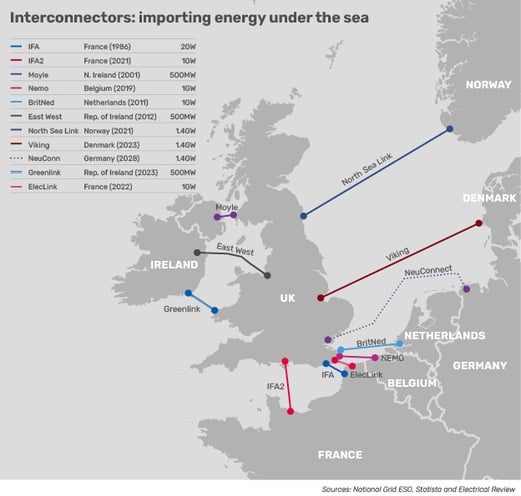Interconnectors are an important part of the UK’s electricity mix. These two-way undersea high-voltage cables allow us to send and receive power to/from our neighbours in response to domestic generation output and peak demand requirements across different time zones. Their performance is a key wholesale-power-market price driver.
In a recent LinkedIn poll, the majority of businesses participating (41%) estimated that the UK imports 20% of our electricity via this interconnector network. However, the actual figure is almost half this! But there are plans to increase this volume, which we discuss further below.
Here are ten key points to answer the most common queries we receive and provide more insight into our UK interconnector network.

- Since the first interconnector was built to France in 1961 (replaced by the IFA link in
1986), the UK has built up a network of nine interconnectors that allow us to share energy with our neighbours in France, Norway, the Netherlands, Denmark, Belgium and Ireland.
- Today, around 11% of the UK’s power comes via our 10.3GW interconnector network – with the potential to supply as much as 15%. This represents an almost ten-fold increase on the electricity imports we received in 2010, when only two interconnectors were operational.
- Interconnectors help to reduce overall energy costs by providing access to cheaper electricity from abroad. National Grid estimates access to these electricity imports could save UK consumers up to £20 billion between now and 2045, if the government’s target of reaching 18GW capacity by 2030 is realised. In terms of system flexibility – of which interconnectors are a huge part – a government study has estimated this could save the UK £10-17 billion in reduced electricity system costs per year by 2050.
- The majority of our electricity imports are supplied by French nuclear via two interconnector links: IFA and IFA2. These typically provide around 53% of our annual import quota. But French power flows are subject to disruption. For example, unplanned maintenance and safety issues can impact France’s aging nuclear reactors. And the interconnector cables themselves can also experience operational issues.
- Since the late 1970s, we have historically imported more electricity than we export. But in 2022, that changed for the first time in 44 years, when problems with French nuclear output and a bumper year for UK wind generation reversed this trend. For that year only, we imported a lot less (just 7.3TWh) and exported far more (10TWh) than in previous years, giving us a net export total of 2.7TWh.
- Late last year, the Viking Link to Denmark came online, becoming the world’s longest onshore and subsea interconnector at 475 miles. Viking Link is expected to supply more than 1% of the UK’s overall supply, mostly from offshore wind – although in the past few weeks, it’s supplied as much as 2.8%.
- The majority of the power we import supports our decarbonisation agenda – for example, nuclear from France, hydro from Norway and wind from Denmark. But the Netherlands, whose BritNed interconnector has been operating since 2011, mostly supplies us with power from fossil-fuel generation.
- The NeuConnect interconnector between the UK and Germany is currently under construction, and is due to become operational in 2028. This 450-mile link will have 1.4GW capacity, which is enough to power up to 1.5 million homes. There are also plans to complete two more interconnectors to France (GridLink and FAB Link) by 2030/1, adding a further 2.65GW of capacity.
- The only three interconnectors where we consistently export more electricity than we import are via our three links with Ireland – one to Northern Ireland and two to the Republic of Ireland.
- One of the more ambitious interconnection projects under consideration is a 10.5GW Morocco-UK connection, via four 2,400-mile sub-sea cables between a solar and wind project in central Morocco and the north coast of Devon. There has also been a 750-mile UK/Iceland interconnector proposed, which could allow us to harness Iceland’s abundant natural geothermal power sources.
/npm214%20Digital_H_UB92.jpg)
/npm214%20Digital_H_UB99.jpg)
/npm214%20Digital_H_UB95.jpg)
/npm214%20Digital_H_UB142.jpg)
/npm214%20Digital_H_UB100.jpg)
/npm214%20Digital_H_UB88.jpg)
/npm214%20Digital_H_UB126.jpg)
/npm214%20Digital_H_UB110.jpg)


/Author%20Profile_Patel_Mo_G.png)

